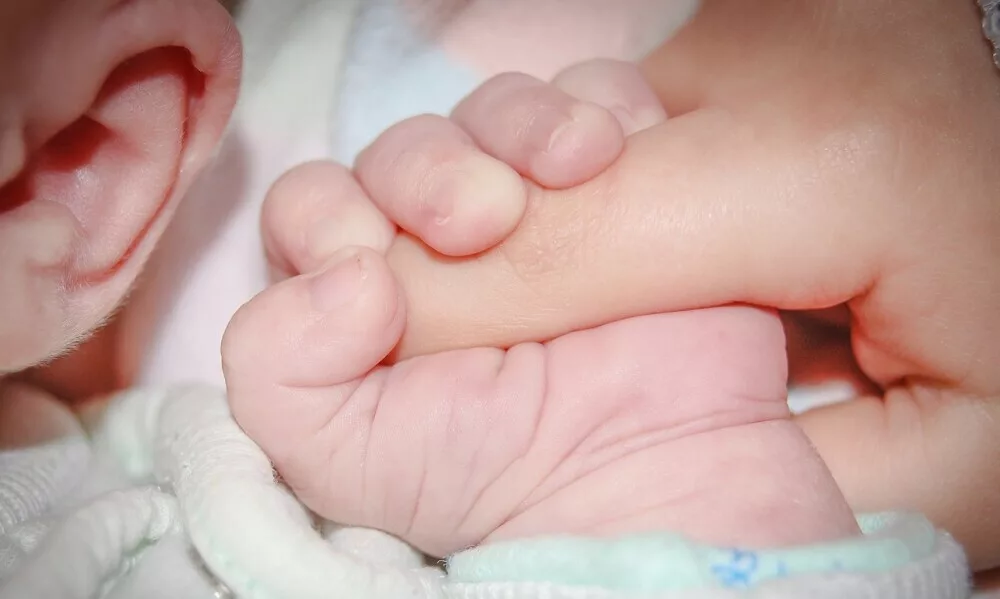Introduction
The image of a newborn suddenly jerking their arms, opening their eyes wide, and appearing startled is familiar to many parents begs the questions, why do babies startle easily? This reaction, known as the startle reflex or Moro reflex, is a normal and natural part of infant development. While it can sometimes be disconcerting, understanding why babies startle easily can help parents better manage and soothe their little ones during these episodes. In this blog post, we’ll explore the reasons behind the startle reflex, its significance, and how parents can support their babies during this phase.

Table of Contents
Why Do Babies Startle Easily: Understanding the Moro Reflex
The Moro reflex, often referred to as the startle reflex, is an involuntary response that occurs in newborns, typically within the first few months of life. This reflex is characterized by a sudden, involuntary movement of the baby’s arms and legs in response to a trigger such as a loud noise, a sudden change in position, or even the sensation of falling.
The Biology Behind the Startle Reflex
The Moro reflex is a primitive reflex, meaning it is an automatic response that originates in the brainstem. It is believed to be a survival mechanism, developed through evolution to help infants respond to potential dangers. When a baby feels a sudden change in their environment, their nervous system triggers the startle reflex, causing them to throw their arms out, open their hands, and then quickly bring their arms back to their body. This response is thought to help the baby cling to their caregiver in case of danger, as would have been necessary in early human history.
Research suggests that the startle reflex is an indicator of a healthy and functioning nervous system. It typically appears at birth and gradually disappears by the time the baby is around 3 to 6 months old as their nervous system matures and they gain more control over their movements.
Sensory Development and the Startle Reflex
Newborns are still developing their senses, and their nervous systems are highly sensitive to stimuli. Loud noises, bright lights, or even sudden movements can be overwhelming for a baby, triggering the startle reflex. The reflex is an automatic response to these stimuli, as the baby’s brain processes the new and potentially startling information.
The startle reflex is most commonly triggered by the sensation of falling or a sudden lack of support, such as when a baby is placed down too quickly or when their head is not properly supported. This reflex can also be triggered by unexpected sounds or even a change in the baby’s environment, such as a sudden gust of wind or the flick of a light switch.
The Role of the Startle Reflex in Infant Development
While the startle reflex can be surprising for both babies and parents, it plays an important role in infant development. The reflex is an early sign that the baby’s nervous system is developing normally and that their brain is able to process sensory information and respond to their environment.
According to the American Academy of Pediatrics (AAP), the Moro reflex is one of several primitive reflexes that babies are born with, all of which serve a purpose in their early development. These reflexes, including the rooting reflex and the grasp reflex, gradually disappear as the baby’s brain matures and they develop more voluntary control over their movements.
The startle reflex also helps babies learn about their environment. Each time they startle, they are exposed to a new sensory experience, which helps their brain process and adapt to different stimuli. Over time, as the baby’s brain becomes more adept at filtering and responding to sensory input, the startle reflex becomes less pronounced.
Why Babies Startle Easily: Key Factors
While the startle reflex is a natural part of development, certain factors can make babies more prone to startling. Understanding these factors can help parents create a more soothing environment for their little ones.
Immature Nervous System
One of the primary reasons babies startle easily is the immaturity of their nervous system. At birth, a baby’s brain and nervous system are still developing, and their ability to process and respond to sensory input is not yet fully refined. This immaturity means that babies are more sensitive to changes in their environment, making them more likely to startle in response to sudden stimuli.
As the baby’s nervous system matures, their brain becomes better at filtering out non-threatening stimuli, and the startle reflex becomes less frequent. By the time the baby reaches 3 to 6 months of age, the startle reflex typically fades away as they gain more control over their movements and reactions.
Sensory Overload
Newborns are still adjusting to the world outside the womb, and they can easily become overwhelmed by sensory input. The sounds, lights, and movements of the outside world are all new experiences for a baby, and their brain is still learning how to process and respond to these stimuli. When a baby is exposed to too much sensory input at once, their startle reflex may be triggered as a protective response to help them cope with the overwhelming environment.
Parents can help reduce sensory overload by creating a calm and soothing environment for their baby. Dimming the lights, using white noise, and avoiding sudden movements or loud noises can all help minimize the triggers for the startle reflex.
Sleep Transitions
The startle reflex is often more pronounced when a baby is transitioning between sleep cycles. Newborns have shorter sleep cycles than adults, and they spend more time in the lighter stages of sleep, where they are more easily awakened by external stimuli. During these transitions, the baby may experience a brief moment of wakefulness, which can trigger the startle reflex.
Swaddling can help reduce the likelihood of startling during sleep transitions by providing a sense of security and comfort. When done correctly, swaddling can help suppress the startle reflex by keeping the baby’s arms close to their body, allowing for more uninterrupted sleep.
Hunger and Fatigue
Hunger and fatigue can also make babies more prone to startling. When a baby is hungry or overtired, their nervous system may be more sensitive to stimuli, making them more likely to startle in response to even minor changes in their environment.
Parents can help minimize the frequency of the startle reflex by ensuring their baby is well-fed and getting enough sleep. Establishing a consistent feeding and sleep schedule can help create a sense of routine and security for the baby, reducing the likelihood of startling.
How to Soothe a Startled Baby
While the startle reflex is a normal part of development, there are several strategies parents can use to soothe a startled baby and help them feel more secure.
Swaddling
Swaddling is one of the most effective ways to soothe a baby who startles easily. By wrapping the baby snugly in a blanket, swaddling provides a sense of security and comfort, mimicking the feeling of being in the womb. This can help reduce the frequency and intensity of the startle reflex, allowing the baby to sleep more peacefully.
It’s important to swaddle the baby correctly, ensuring that the swaddle is snug but not too tight, and that the baby’s hips and legs have room to move freely. The American Academy of Pediatrics recommends swaddling as a safe sleep practice for newborns but advises parents to stop swaddling once the baby shows signs of rolling over.
Holding and Rocking
Holding and gently rocking the baby can also help soothe them after a startle. The close contact and rhythmic movement can help calm the baby’s nervous system, reducing their stress levels and helping them feel secure. Skin-to-skin contact is particularly effective, as it can help regulate the baby’s body temperature and heart rate, promoting a sense of calm.
Creating a Calm Environment
Reducing the amount of sensory input in the baby’s environment can also help minimize the triggers for the startle reflex. Dimming the lights, using a white noise machine, and avoiding sudden movements or loud noises can create a more soothing atmosphere for the baby. This is especially important during sleep, as minimizing disruptions can help the baby sleep more soundly.
Conclusion
Babies startle easily due to the immaturity of their nervous system, their heightened sensitivity to sensory input, and the natural protective mechanisms they are born with. The startle reflex, while sometimes surprising, is a sign of a healthy and developing brain. As babies grow and their nervous system matures, the startle reflex gradually fades away, giving way to more controlled and voluntary movements.
Understanding the reasons behind the startle reflex can help parents better support their baby during this phase. By creating a calm and soothing environment, using techniques like swaddling, and being mindful of the baby’s needs, parents can help reduce the frequency of startling and promote a sense of security and comfort for their little one.
Sources:
- American Academy of Pediatrics. (2016). Swaddling and Safe Sleep Recommendations. AAP Publications. Retrieved from AAP Publications
- Karp, H. (2002). The Happiest Baby on the Block. Bantam Books.
- American Academy of Pediatrics. (2016). The Startle Reflex in Newborns. AAP Publications. Retrieved from AAP Publications
- Leach, P. (2010). Your Baby and Child: From Birth to Age Five. Knopf.
- National Center for Biotechnology Information. (2011). Infant Reflexes: Developmental Markers and Their Importance. NCBI. Retrieved from NCBI.
